Nurse Log
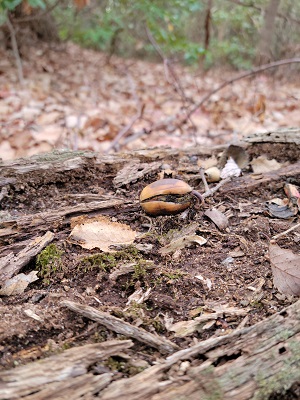
Photographed at
Huber Woods Park on the Many Log Run trail, a fallen tree provides a unique opportunity for young plants. Known as a nurse log, decomposers like fungi break down the wood into a loose substrate. Any seeds that find their way to this newly created substrate will have a chance to grow upon it. Enter our baby oak tree as pictured above. This acorn likely fell from one of the many oaks growing nearby. If you look closely, on the right side of the acorn you can see its taproot has emerged and begun growing into the nurse log. (posted 12/17/2021)
Pink-Footed Goose
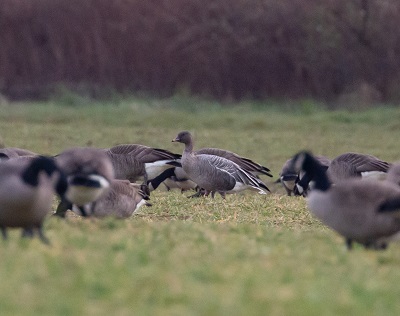
A Pink-footed goose was recently spotted at
Thompson Park, Lincroft. Imagine playing real world "Where's Waldo?" while looking and sifting through hundreds of Canada Goose all in a field. That is exactly what local birders were doing the other day as word got out about our not-so-common visitor. Pink-footed geese are known to nest in Greenland and Iceland and spend part of the year northwestern Europe. A few strays will wander into eastern North America. They are quite similar in size to the Canada Goose but have brown head, black bill with pink marking, and pink feet that make them stand out.
(posted 12/13/2021)Scissor-tailed Flycatcher
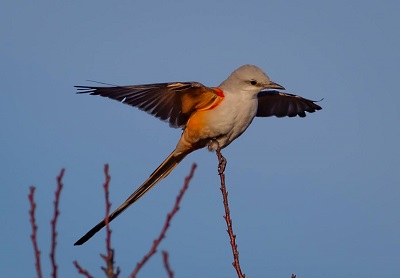
Recently there was a sighting of a Scissor-tailed Flycatcher in Monmouth County at the Sandy Hook section of Gateway National Recreation Area. This beautiful flycatcher has gray coloration, a hint pink coloration, and an extremely long tail. A rare and elegant visitor, the Scissor-tailed Flycatcher is known to perch in the open along treetops, fence lines, and even power lines in the South Central United States. The last time one was spotted in a Monmouth County park was back in 2011 at Huber Woods Park by now-retired Park System Naturalist Sam Skinner. These birds are experts at catching insects midair in spectacular acrobatic fashion. (posted 11/22/2021)
Black-headed Gull & Bonaparte’s Gull
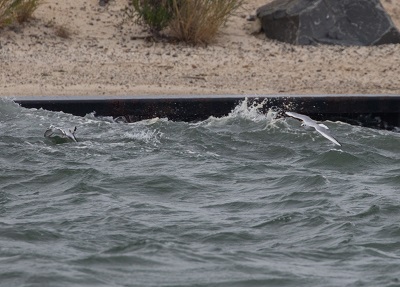
Black-headed Gull & Bonaparte’s Gull
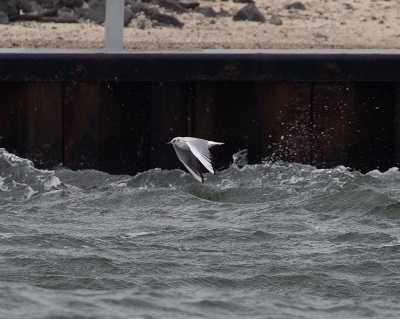
Black-headed Gull
Recently, an interesting bird has been appearing at
Fisherman’s Cove Conservation Area in Manasquan - a Black-headed Gull. Seen hovering low over the water in the channel during a stormy day, it had adult non-breeding plumage. Distinguishing features to look for in the Black-headed Gull are a reddish bill and a dark ear spot. Also spotted was a Bonaparte’s Gull. This winter bird has a thin dark black bill and dark ear spot.
(posted 11/16/2021) Cattle Egret
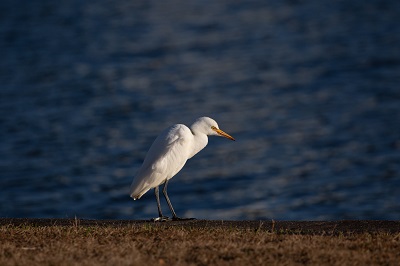
This Cattle Egret was hidden in plain sight along one of the many Monmouth County lakes found near the ocean. It is a short stocky egret not typically found in Monmouth County. Usually seen near livestock, they feed primarily on insects in upland habitats. A more southern ranged species, they sometimes fly a little further north in the fall before migrating south for the winter. (Perhaps they are scouting locations for the next year.) This year, we’ve been very excited to see quite a few reports of these birds in our area. (posted 11/16/2021)
Close to Shore
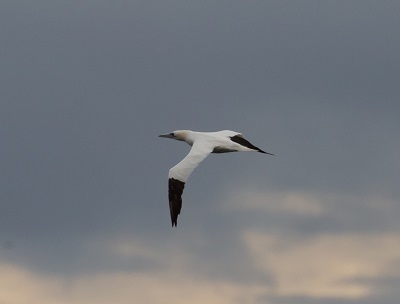 Northern Gannets
Northern Gannets
Sometimes storm conditions present the chance to see some species that you normally wouldn’t. With recent storms passing off the coast, our Naturalists were able to spot some interesting birds at Seven Presidents Oceanfront Park including Northern Gannets. Adults are large white birds with black wingtips, black outlining on their bill and face, and a blue eye ring. Spotted close to shore, it was one of those great wildlife spectacles to witness - hundreds of these birds flocking together, raining down, and diving deep into the ocean waters to catch fish.
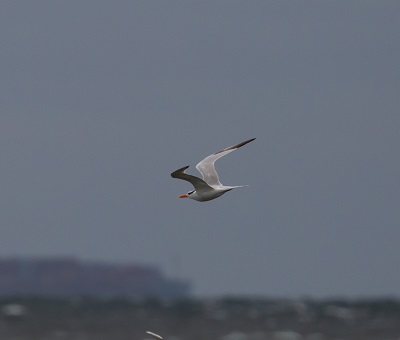
Royal Tern
Another bird that could also be seen diving for fish that day was the Royal Tern. They are one of the larger species of tern found in New Jersey. Normally, they have a large orange-colored bill and black cap and crest, but during the fall they lose their cap and show more white on their heads.
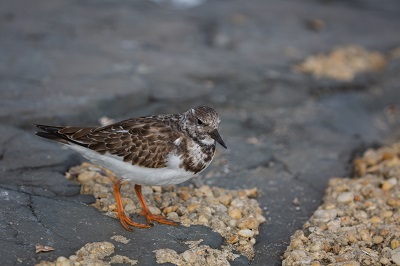
Ruddy Turnstone
Also hidden close to shore, foraging along the rocks, was a lone Ruddy Turnstone. It is a beautifully colored shorebird in its breeding plumage calico-like coat. Even in its nonbreeding plumage, it is stunning with unique, black roundish markings on its chest, a stocky short bill, and bright orange legs. These birds like to hang out on the rocks and jetties along the coast, searching for insects and small crustaceans to eat. (posted 11/16/2021)
Lark Sparrow
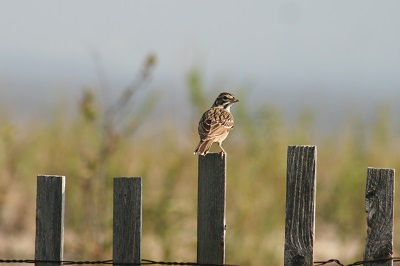
Sometimes you can find an unexpected gem during unlikely times. Over the past weekend, as staff was setting up for the Wind and Sea Festival at Bayshore Waterfront Park a bird caught the eye of Park System Naturalist Paul Mandala. Using a pair of binoculars, he was able to spot a Lark Sparrow that perched briefly on the fence of the main path. This large species of sparrow has a very distinctive facial pattern that makes them really stand out, described as a harlequin facial pattern. This was the first time one was spotted at Bayshore Waterfront Park and that is no surprise as their typical range is on the west coast and central parts of the United States and Mexico. (posted 9/21/2021)
Wood Duck
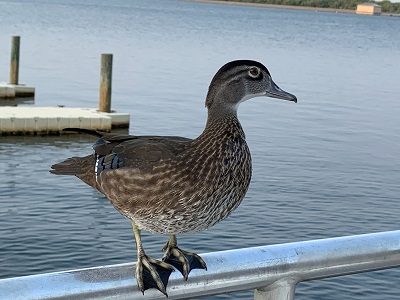
Wood Ducks are a stunning species of ducks and like many other species, the female may get overlooked. However, even the female of this species are gorgeous. Wood Ducks are usually very timid and hard to spot, preferring secluded, wooded swamps. The Naturalist staff at the Manasquan Reservoir, Howell, were very fortunate during a recent September boat tour to have encounter such a stunning and friendly visitor. In this photo, you can see in detail her webbed feet and the white ring around her eyes. (posted 9/20/2021)
Salad Eating Contest Anyone?
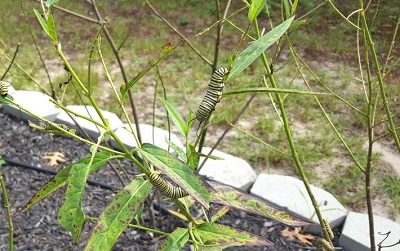
See full size image.
These very hungry monarch caterpillars are hard at work, chomping away at the foliage of some swamp milkweed plants, also known are Asclepias incarnata. Over time, they will dramatically increase in size by molting through five instar sizes. Can you find all seven caterpillars pictured above?
All milkweeds contain toxins called cardenolides, which protect the plants from most forms of herbivory. Through coevolution, monarch caterpillars have become specialized in eating milkweed leaves, resulting in becoming toxic themselves. Due to this specialization, monarch butterflies depend on milkweed plants exclusively as host plants for their offspring.
Come visit Freneau Woods Park, Aberdeen, and check out the new Monarch Waystation where this photo was taken.
Random fact - monarch caterpillars often eat their own molts before continuing to feed on milkweed leaves. (posted 9/1/2021)
Manasquan Reservoir Eaglets Fledge June 6, 2021
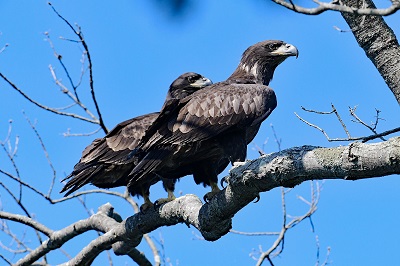
Photo by D. Ruffe 6-6-21
Manasquan Reservoir’s two eaglets have taken their first flights! This milestone, called fledged, was reached on approximately Sunday, June 6. They were spotted together on a limb about 50 yards from the nest. Hatched on March 14, they are now about 11 weeks old. In terms of development, they have fledged right on time and are now considered “juvenile” eagles.
While this marks the start of becoming independent, they must improve their flying skills and learn to hunt for themselves. The nest is still their home base for the next seven weeks or so. Through July and August, we will see them less and less around the Manasquan Reservoir. Eventually, they will leave the area and become nomads with no territory of their own. Juvenile eagles from our area tend to roam from the Chesapeake Bay to Maine until they mature, at which time they return to general area where they were raised.
The photo shows their dark feathers, beak and feet. These dark colors act as camouflage to provide protection. It also differentiates them from mature eagles. They keep this specific coloration for about six months. Bald Eagles’ plumage continues to change throughout their development; it takes five years for the young birds to fully mature and acquire the classic white head and tail. (posted 6/11/2021)
Wildflower Rock Art
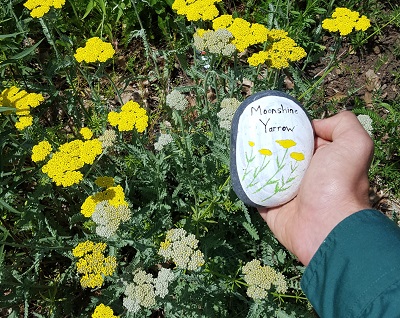
While on a stroll along the Huber Woods Discovery Path, you might come across some peculiar artwork like the painted rock pictured above. Acting just like plant labels, these rocks help showcase what each plant will look like even if it isn’t currently in flower. Stop by for a visit to see how the pollinator garden changes over time.
If you are interested in creating your very own rock art under the guidance of our green-thumbed painter, feel free to sign-up for our Wildflower Rock Art programs in July and August.
Can You Dig It?
Millions of years ago when dinosaurs literally roamed the Earth, most of New Jersey was underwater— including our very own Monmouth County! Fortunately for us, this means we can now find marine fossils along stream beds in the area. These can date back over 65 million years to the Cretaceous Period.
Fossiling is truly a great way to go back in time; no flux capacitor needed! Want to try? Join one of our Naturalists for Fossiling at Shark River Park on Saturday, June 5. Our Naturalist will show you where to look and how to find fossilized shark teeth. An additional session is offered on Thursday, June 24. (posted 5/19/2021)
All That Glitters is Goldfinch
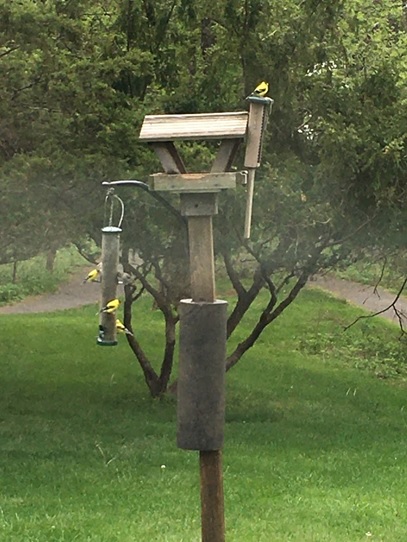
The Eastern Goldfinch, or Carduelis tristis, is the official state bird for New Jersey and can be found year round throughout our Monmouth County Parks. Males are identified by a bright yellow body with black wings and tail, and black on top of their head. Female feathers are a more yellowish brown with dark brown wings and tail (males will also display similar colors in the winter months).
Goldfinches also breed later than most North American birds, nesting in June or July when seeds are usually more abundant. Their nests can typically be found in deciduous shrubs or trees less than 30 feet above the ground, and are so well made that they may even hold water!
A Goldfinch will lay between 2 and 7 eggs and have an incubation period of approximately two weeks. While the female does all of the incubating, both parents will take turns feeding the nestlings. Initially the male will bring the food to the female who will then feed their young, but over time they will both feed. Around 11-17 days after hatching, the young Goldfinches will leave the nest to strengthen their own survival skills.
Goldfinches are a popular bird to find at the feeders behind the Huber Woods Environmental Center. Their diet consists primarily of various seeds such as milkweed, purple coneflower (among other daisy-like flowers), sunflower, and thistle. These are great seeds to stock your own feeders and gardens with if you want to attract these beautiful birds to your yard!
Bobolinks
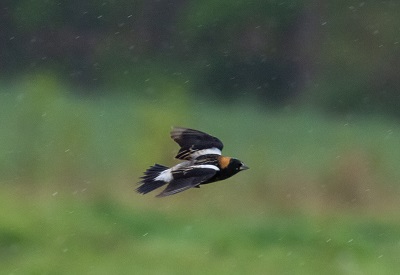
Bobolinks are a stunning member of the blackbird family. It is a bird of open fields that perches on grasses. The males are stunning with their white back and black underparts, and straw-colored patch of feathers on the back of their heads. While uncommon visitors to Monmouth County, they sometimes stop during migration in parks like Thompson Park or Dorbrook Recreation Area, and are a wonderful treat to see.
Evening Grosbeak

The Evening Grosbeak is a striking heavyset finch that is rarely seen in Monmouth County. This winter was a particularly good year for finch migration, with birds pushing further south than typical. These birds are migrating back to the northern coniferous forests in the northern United States and Canada. We were lucky to have had a flock of these beautiful yellow thick billed finches stop over for a snack up at Huber Woods Environmental Center. They were seen feeding on some berries from a tree in the parking lot. (posted 5/11/2021)
Roses Are Red, Violets Are Blue…
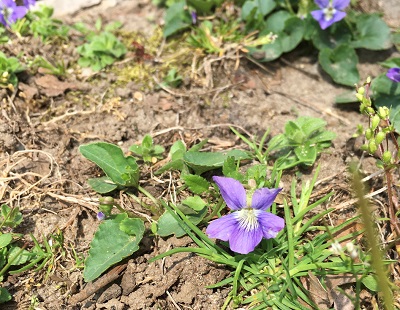
Did you know that the common blue violet is the state flower for New Jersey? Common blue violets (Viola sororia) are short-stemmed herbaceous plants that are native to northeastern America. Their heart-shaped leaves are topped by beautiful purple blooms with white “throats.”
You can find these flowers in several of our parks such as
Freneau Woods Park, Aberdeen, in the early spring months, typically March through May. Since there aren’t many insect pollinators awake yet at that time of year, violets have developed cleistogamous, or self-pollinating, flowers that bloom later in the season.
Legislation to adopt the flower as a state symbol existed in 1913, but it wasn’t until 1971 that it finally passed thanks to the urging of New Jersey garden clubs across the state. (posted 4/30/2021)
Two Eaglets at the Manasquan Reservoir!
3-29-21
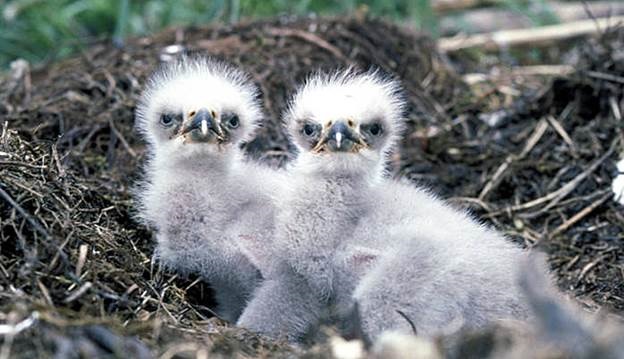
Photo courtesy of USFWS
Naturalists at the Manasquan Reservoir Environmental Center are excited to announce that two eaglets have been sighted in the nest. This year’s nest is more shallow than usual which has made spotting the chicks much easier. At present, they are small and covered with white downy feathers. However, they are growing at an amazing rate, gaining up to one pound a week. At nine weeks old, they will be the size of a fully grown adult eagle which can weigh between eight and twelve pounds (depending on the sex). Females are larger than males. Although they grow rapidly, they are not yet mature. They must continue to learn to fly and hunt and will stay near their nest for about six months. Eagles fully mature in five years.
The Bald Eagles’ nest and surrounding area are protected. They are very sensitive to disturbance by humans. Approaching a nest could cause them to abandon their eggs or young. Please do not approach the nest or enter any protected areas. The nest can be viewed safely from the Manasquan Reservoir trail adjacent to Georgia Tavern Road or from inside the Manasquan Environmental Center via live television monitor. Overcast days make the best viewing from the Manasquan Reservoir Environmental Center’s television monitor as they provide the clearest images. (posted 3/29/2021)
Manasquan Reservoir Bald Eagles’ Eggs Hatch 3-12-2020
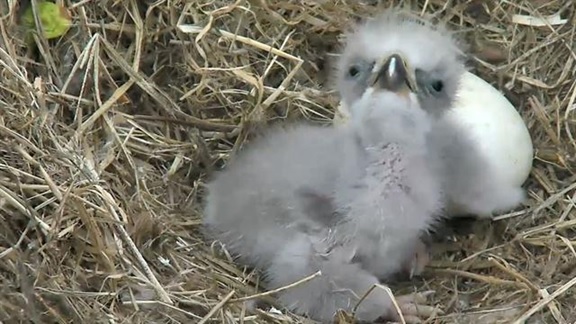
Photo from US Fish & Wildlife
During the second week of March, Park System Naturalists at the Manasquan Reservoir Environmental Center, Howell, were closely watching the site’s Bald Eagle nest for signs of hatching. It began right on time (35 to 40 days after the start of incubation on February 2) when late Friday afternoon, March 12, the adult eagles were observed reaching down into the nest and delicately feeding their chick(s). At this time, we don’t know the number of eaglets. The newly hatched offspring are too small for us to see. As the days go by, we may see a head or a wing pop up as they grow bigger and stronger. It will be a couple of weeks until we know the actual number of chicks.
Please be aware that nesting Bald Eagles are very sensitive to disturbance by humans. Approaching a nest could cause them to abandon their eggs or young. Please do not approach the nest or enter any protected areas. The nest can be viewed safely from the Manasquan Reservoir trail adjacent to Georgia Tavern Road or from inside the Manasquan Environmental Center via live television monitor. (posted 3/18/2021)
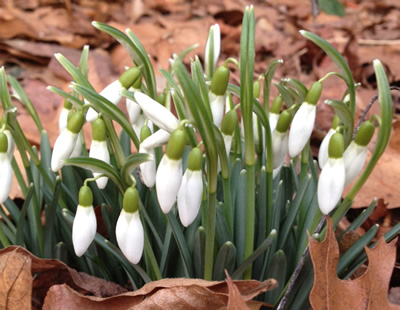
Galanthus nivalis, commonly called snowdrop, is a bulbous perennial that is native to Europe. It has escaped gardens and naturalized in parts of eastern North America. It is a true harbinger of spring that typically blooms from late February to late March, often poking its head up through snow cover if present. (Re-posted 3/16/2021)
Common Redpoll
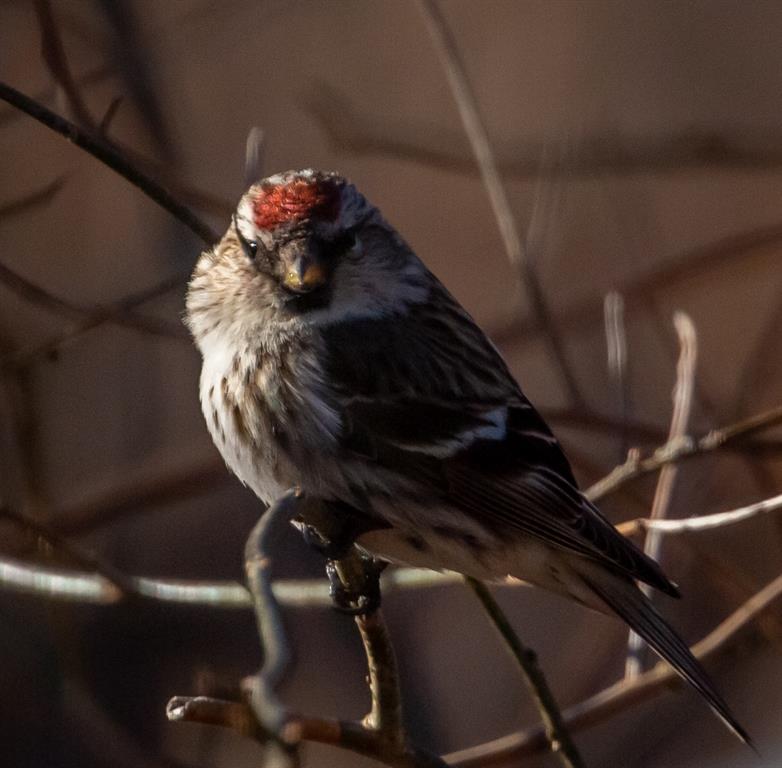
Recently at Big Brook Park, Marlboro, we had an unexpected guest! A lone Common Redpoll was spotted visiting the feeders at Neuberger Lodge. Common Redpolls are rarely seen in Monmouth County and only visit during the winter season in irruptive years. A small energetic finch that actively forages for food, it has a small conical yellow bill and heavily streaked back and sides with a distinctive red patch on the crown of its head. Common Redpolls are known to occasionally tunnel into the snow to stay warm during winter nights. (posted 3/9/2021)
Sandhill Crane
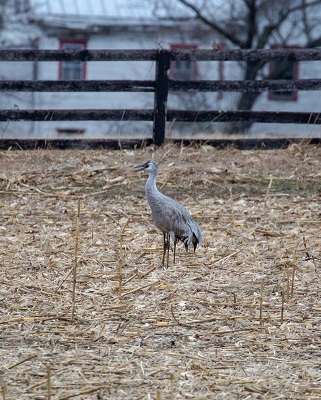
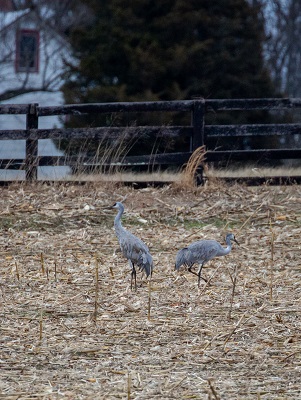
A large bird was recently spotted in a cornfield by one of our Park System Naturalists while driving along Emely’s Hill Road in Cream Ridge, just down the road from the entrance to Clayton Park's trail head. The bird stood out as being oddly tall and had an overall greyish appearance. It turned out to be a Sandhill Crane which stands at over three feet tall. They are beautiful and elegant birds and, if you look closely, have a red crown on their heads. It’s a real treat to be able to see one in Monmouth County as they are not a common visitor. Interestingly, some people have actually theorized that some of the Jersey Devil sightings may have actually been Sandhill Crane sightings. (posted 2/26/2021)
Snowy Owl
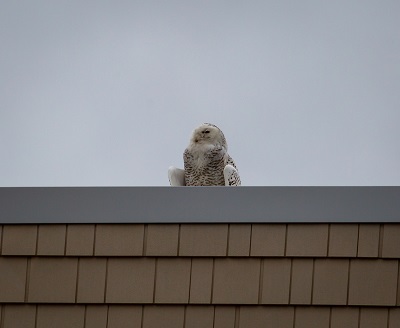
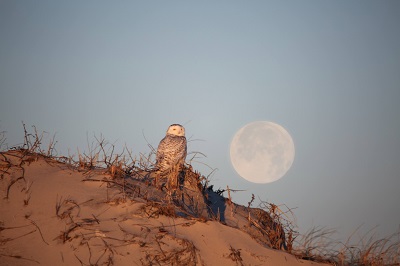
Winter can bring lots of excitement to the Jersey Shore, and some years brings an influx of bird species that are not commonly seen as these birds push down from ranges further north. Recently, a Snowy Owl made an appearance and became a local celebrity – giving us a great opportunity to share our owl knowledge.
Snowy Owls like to frequent dunes and beach habitat as they hunt for prey. Dunes give them a nice, high vantage point to hunt successfully. While they’re found in the habitat of places like Seven Presidents Oceanfront Park, you never know when and where they will show up. Exact locations for owl species and other sensitive or endangered species should not be shared as roosting (resting) locations are important for the animal. An influx of people, cameras and attention may cause them stress and hurt their chances of hunting prey successfully.
Thankfully, the owl pictured perched high atop an apartment complex, seemed to have enough distance to be comfortable. A good rule of thumb is to view wildlife from a distance with the use of binoculars or a scope; and that your actions should not change their behavior. (posted 2/26/2021)
Incubation Begins for Bald Eagles at the Manasquan Reservoir!
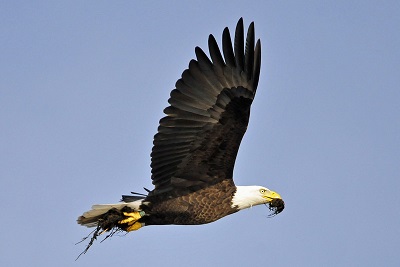
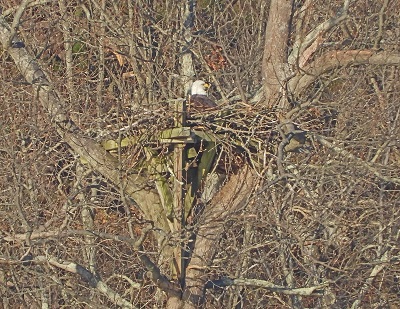
We are very happy to announce that the resident Bald Eagle pair began incubation on February 2. Naturalists observed the female sitting low in the nest and remaining there. From now on, one of the adults will almost always be seen in the nest. The female eagle begins sitting immediately upon producing her first egg. She may lay up to three eggs over the next five to six days. The male assists with incubation by giving the female breaks. He also brings food to the female and helps protect the nest. If everything goes well, we expect hatching to occur the second week of March. They are nesting in the same nest as last year.
Nesting Bald eagles are very sensitive to disturbance by humans. Approaching a nest could cause them to abandon their eggs or young. Please do not approach the nest or enter any protected areas. The nest can be viewed safely from the Manasquan Reservoir trail adjacent to Georgia Tavern Road or from inside the Manasquan Reservoir Environmental Center via live television monitor. (posted 2/5/2021)
Red Crossbill
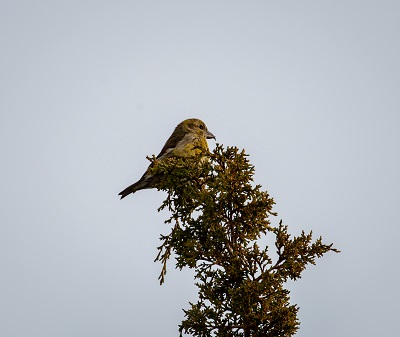
Don’t let the name Red Crossbill confuse you. Pictured above is a female Red Crossbill. Females have a yellow-green coloration compared to the red coloration of the males. Finches, including Red Crossbills, are experiencing an “irruptive” year. This is most likely due to an unproductive crop of its conifer food sources (further north) that has them wandering out of their normal range in search of seeds. These foraging Red Crossbills feed on the cones of their favorite evergreen trees such as pines, hemlocks, Douglas-firs and spruces. They use their very specialized “cross” bill to break open cones. This female was seen actively feeding on the cones of the pine trees found at Seven Presidents Oceanfront Park. (posted 1/20/2021)
Dovekie
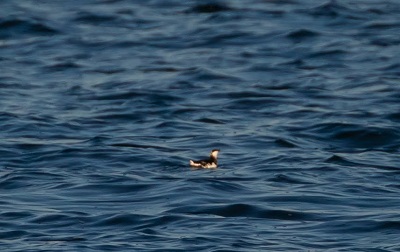
Seeing a Dovekie from land is rare and something most birders do not get a chance to do in New Jersey. According to Cornell Labs’ All About Birds webpage, Dovekie are one of the most abundant seabirds in the Northern Hemisphere but they live so far north that relatively few bird watchers get to see them. However, there seems to be a unique phenomenon this January with reports of Dovekie being seen along the coast of New Jersey from various points at the same time.
A few lucky birders were able to see Dovekie, a tiny 8.5 inch, black and white, and roughly football-shaped Auk, through binoculars and scopes. These birds spend most of their time at sea. They feed by surface diving down for small aquatic invertebrates and zooplankton. When they do come to land for the breeding season, they nest on cliffs in the high Arctic. If you wanted to try sea watching in your Monmouth County Parks, the beaches of Seven Presidents might just grant you a brief glimpse at these adorable birds. (posted 1/13/2021)
Possible Bullock's Oriole Sighting at the Manasquan Reservoir
Bullock's Oriole (ID awaiting confirmation from the NJ Bird Records Committee)
This winter has been a great season for seeing Baltimore Orioles at parks and home feeders in New Jersey. As all good birders know, it's always important to look at the fine details on a bird because you never know what might be hiding in plain sight. This December at the
Manasquan Reservoir, a report of an interesting looking Oriole came in that seem to be identified as a Bullock's Oriole, a species normally found on the west coast. The overall greyish back, white belly, and yellowish chest gave a first clue, and the black in the throat and black eye line help confirm the ID as a first year Bullock's Oriole. If accepted by the New Jersey Bird Records Committee, this may be only the fifth record of a Bullock's Oriole spotted in New Jersey, and the first for Monmouth County. (
posted 1/8/2021)
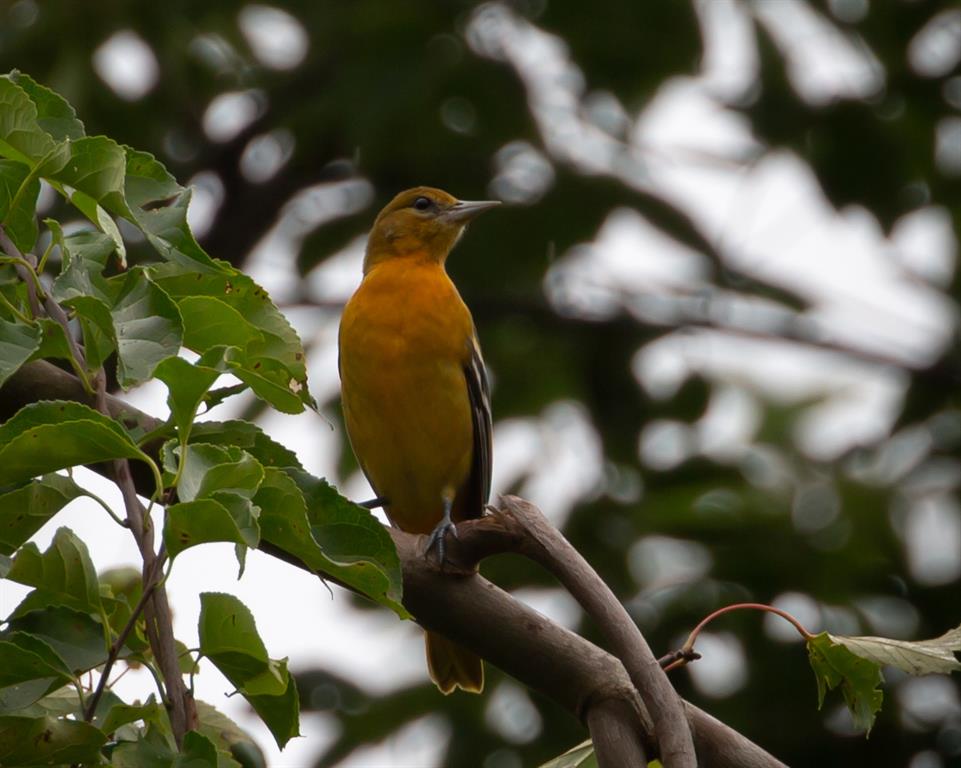 Baltimore Oriole (for comparison)
Baltimore Oriole (for comparison)